Radio W4KAZ Thanks for stopping by the virtual KazShack. Feel free to comment - I often approve them.
|
By w4kaz, created on 2012.03.23 at 05:42:22 | last changed on 2012.03.23 at 10:44:30 | When I upgraded the dead computer a couple of years back, I stuffed the current machine(Dell Inspiron 545S w/Pentium Dual-core E5300 @ 2.6ghz) with 8GB of RAM, expecting to do some experimentation with running VMware or some such to tinker with PC based VM’s. Â After looking around a bit, other shiny objects attracted more attention. Â So, being easily distractable…..VM’s slipped down the memory hole.
Fast forward to present. Â Looking over at the Oracle VirtualBox website, a bit of light reading showed that a lot of work has been done on their VM software in the last 18months. Â More robust USB support, and a lot of bug fixes. Â Its free for personal use, so give it a shot.
The VirtualBox software itself installed on Windows 7 Â easily. Â Within a few minutes after that, A VM for an Ubuntu Linux partition was ready for the OS install. Â Virtualbox is able to install an OS from an ISO disk image. Â So after a few minutes waiting for the latest Ubuntu 11.10 version to download, the VM was ready to install. Â It took longer to download the ISO than it took VirtualBox to install the OS(unusually slow day for the internet connection to blame there).
The quick summary is that Ubuntu runs well inside the VM sitting on a Windows7 host. Â I expect that the opposite is likely to be a more desirable arrangement, but living in the real world, there it is. Â I expect to use the Ubuntu partition to allow tunneling over to the Linux server box using VNC to control the desktop on the remote server. Â Its possible to set that up using something like TightVNC under windows, but the whole thing is a lot simpler to configure in a Linux to Linux environment. Â The VM runs on the windows desktop just like another windows application. Â Nice and simple.
More complicated hardware interfaces are probably a lot more difficult to configure(if they are possible at all), but outside of some radio control software, I don’t expect to need to delve that deeply. Â I suppose there will be latency issues based on some comments from N4AF, but curiosity may eventually point me in that direction anyway.
Unrelated sidenote, but after installing the 11.10 version of Ubuntu, I immediately ditched the “unity” desktop and reverted to “gnome”. Â Another “Unity = new coke” example? ? ? Â [Comments appreciated on this topic]
A second VM is now set up with a small Windows XP partition using the Windows XP license from the dead desktop.  It turns out that XP was a bit more difficult to install.  The problems were probably due to hardware conflict issues between VirtualBox and the host over the CD-DVD drive.  After ripping  XP to an on-disk ISO, installation made much better progress.
It turns out the XP partition will be handy for running the version of EZNec I have. Â Later versions of EZNec have a 32 bit installer, but the last edition I have is using a 16 bit installer which will not work with 64 bit Windows 7. Â So now EZNec has a home on the desktop again, even if its inside a shell running on top of the shell. Â In fact, the EZNec install on an XP VM runs quite a lot better than I expected – much faster than on a P4 with 1 GB of ram.
So for some select older applications, an XP VM in the VirtualBox world is a viable option.  It’s a kludge, but potentially a very useful kludge.  Another very useful aspect is that the VM’s can be very easily copied.  Useful for backups and migration.  And always having a pristine version saved could be handy.  I’m tempted to start saving pennies for a multicore processor machine with the latest/greatest fast CPU’s and memory, and use a VM for everyday usages.  Also curious if running the VM’s over a Linux host OS ultimately makes more sense.
Latest-n-greatest is wonderful, but I just hate leaving behind programs that work perfectly well. Â CT anyone? Â OK, maybe not….
O’course the bleeding edge crowd will still descend into hysterics over the concept of “continuing to drive the 1984 Honda Civic”, but I figure they have enough cash in their pocket to not be concerned with the trivial expenses involved in their upgrades to all new replacement software.  If it were not just for a  hobby tinkering project, maybe I’d agree.
“Better” is such a subjective concept, aina?
By w4kaz, created on 2012.01.27 at 18:05:45 | last changed on 2012.01.27 at 18:05:45 | Getting the last minute woolgathering in before the contest begins.
Made a last-minute antenna mod to the Inv-L with K2AV FCP. The antenna matching network has been ready for switching out matching capacitors for over a year. The missing piece has been a control box and control cable to the feedpoint. After a bit of consideration of solving this issue before the contest, the brain caught up and realized an interim solution was already in place.
When the Sixpak was added to the antenna system a couple of years back, the existing seven position switch was pressed into ‘temporary’ service as an A/B switch for a pair of 40m dipoles. But they occupy positions 1 & 2 on the switch.
So why not use the other switch positions to serve double duty? The switch is about ten feet from the base of the 160m antenna, so its a short run of control cable versus the 80 run needed back to the shack.
So as a quick and dirty solution, I hacked together a plug to mate to the switch control line. Just plug the 160m switch into the control cable for the seven position switch.
Presto-change-o. Now I can move the best match on 160m from 1820 up to 1845. Sufficient for a CW contest, although 1855 would be ideal. More tweaking needed, but better.
Goals for the weekend are more or less to lay down a good set of spots into the Reverse Beacon Network. No real QSO goals. Try to maximize time spent running, and try to do it over two nights.
C U LÂ Â de w4kaz
By w4kaz, created on 2012.01.20 at 06:48:47 | last changed on 2012.01.19 at 12:11:53 | One of the things that kept me away from the keyboard was a woodwork project idea.
Several years back, I saw a design for a compact kitchen/breakfast table. The tabletop folded over to convert the table into a bench. The basic idea was used to build two outdoor tables of similar design. They are very functional, but a bit heavy. One is in daily use as a catch all work table. The other slightly larger table is on the backyard patio and is used with the tabletop grill.
The eldest son moved to an off campus apartment which has a large deck. It seemed like a good place for a similar table. So it was time to pencil out a new design that I could put together for an updated “new and improved” version. Several years of use had made some of the shortcomings of the original tables obvious. The “new” ideas are that: 1) it needed to fit into the car for transport, and 2) should be made of lighter weight materials to generally make it easier to move around. This is what popped out…….
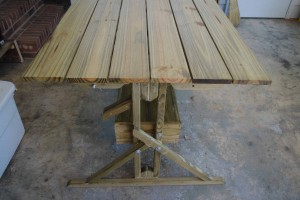 First attempt at picnic table bench Not a terribly good photo, but there are a few more coming.
The table has four components: 2 sides, the top, and the bench. The sides are simply bolted to the bench with 1/4 inch carriage bolts, while the top rests on top of the top arms of the side pieces. The top is simply pinned into place using 1/4 inch J bolts. The top itself is formed from boards attached to ribs with deck screws, all countersunk from below keeping the tabletop unblemished.  The table top hinges over on the rear pair of J-bolts to become the backrest for the bench. Pictures are better….
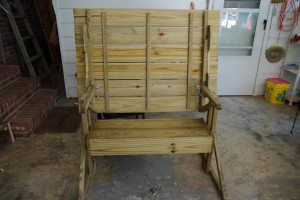 Picnic table with top folded back as bench. The materials used are all pressure treated pine lumber. To give the surfaces a bit of a protective finish, the table top got four or five coats of good old-fashioned pure tung oil, which incidentally has become difficult to find. I like tung oil – it is more resistant to mold and mildew, so is better for an outdoor application than boiled linseed oil, and I expect it to hold up in the mountain UV sunlight a lot better than a polyurethane. After its dried, tung oil is also resistant to alcohol and related solvents. Good stuff. I suppose it has fallen from favor because of the rise in popularity of the polyurethanes, and the substitution of the less expensive boiled linseed oil finishes. It was also a bit of an experiment, as none of the other normal finishes are worth a flying-*#%^ on pressure treated lumber, whereas tung oil does a better job on this material and is non-toxic, unlike oils designed for treating pressure treated decks.
So the table top and bench have a nice hand buffed tung oil finish. Its difficult to tell in these photos, but that experiment was proven to be effective.
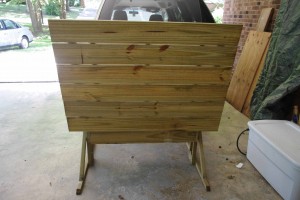 The back of the bench As it turns out, the selection of pressure treated that happened to be in the bin at the big-box-lumber-retailer included several nice heart-pine crosscuts, which had nice colored grain detail. The coloration was enhanced by the oil finish. It really looks a lot better than I expected. Almost kept this one and made a second table for NumberOneSon. 😮
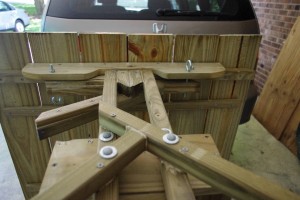 side view of bench attachment to side arms |
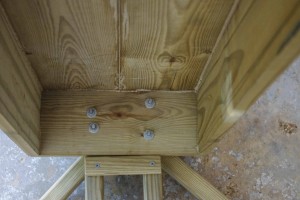 Inside/underside view of bench attachment to side arm |
The problem areas in the design relate to the hinging of the table top and its use as a seat back. The sides of the table are made from deck ballusters. I’ve found that these are generally cut from knot free sections of clear even-grained wood, and are quite strong. Also relatively inexpensive. So the side sections are held together with deck screws and waterproof polyurethane exterior construction adhesive. The top rail may not be strong enough for the hinge, and may eventually need a re-inforcement of steel or aluminum added.
Also, the original benches had wider sides, which served to “stop” the bench top fold over at just over 90 degree seat back angle. Solving that problem on this new bench did not occur to me until it became clear the sides here will allow the top to hinge over well past a comfortable seat-back angle. So the kludge to remedy that design flaw was a simple chunk of balluster attached at angle on the inside of the sides. It helps add rigidity to the sides as well as acting as a bumper for the table top when hinged over as a seat.
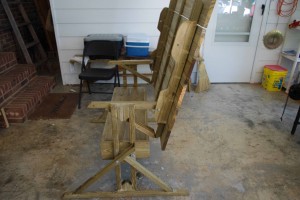 Side view of table with top hinged over for use as bench Just right for soaking up a bit of mountain sunshine – and hopefully the moonshine won’t eat away the finish.
By w4kaz, created on 2010.12.29 at 17:22:13 | last changed on 2011.01.06 at 13:23:42 | Given the plethora of P4 boxes showing up in recycle bins as companies migrate off of WinXP, a recent reclamation opportunity made it seem like a good time to save some landfill space and cobble together a Linux file server. So with a scrap Dell GX280 in hand, the file server/testbed project saw some attention. Stuffing an extra couple of memory sticks into the obsolescent GX280 brought it up to 2GB. The GX280 should be a very usable Ubuntu or WinXP platform with 2gb, so its a great shack backup too. The limitation was the hard drive. A spare 80gb drive is set up with WinXP, and an el-cheapo 500gb drive went in for the Ubuntu install. Not phenomenal, but not bad for under $75USD. Hell, it would have been useful without the upgrades.
The Dell GX280 seems to be well supported by Ubuntu – all of the peripherals are up and running after the install, no hardware/driver hacking required. Installed Ubuntu 10.04(lts). The GX280 is widely available as scrap. Kind of like throwing away a good pre-1974VW Beetle was back in the 1980’s. Not too sexy, but still serviceable enough for generic mundane uses. Wish I had grabbed more of them[VW’s and GX280’s]. [Aside: Both my 1968 Beetle and my wife’s 1984 Honda Civic hatchback got better mileage(48mpg and 42mpg respectively) than today’s EcoWeenie “hybrids” get in real life usage. Ain’t “progress” something to behold?]
Networking the boxes turned out to be the biggest roadblock, and it is still an incompletely resolved situation. That’s not related directly to the hardware, but to the mix-match of OS’s in the network. The home experimentation network consists of Win7, WinXP, and Ubuntu 10.04 boxes. All of the boxes can see the others. The symbolic names are mostly useless, as only the XP and win7 boxes can access each other using the symbolic names[sometimes]. The linux boxes can share files, but only by using their IP addresses, even with the XP boxes. Obviously user error setting up Samba shares. Not a major issue when the router assigns the internal IP’s, providing an alternate route, but far from perfect. Windows 7 isn’t playing nice with any of the others, probably related to the user security.
So for the present, IP address’ are the ticket. Kludgy at best, but mapping the drives by IP address works across the platforms. Not really any more difficult to use the IP’s. Since they are mapped at the router, its probably easier to remember the box numbers anyway.  “x.x.x.157 is what????”
The good news is that setting up SSH on the Ubuntu platforms was simple enough that even a linux noob can figure it out.  SSH security tips are widely available. With an X-window client and PuTTY installed on the windows side, any of the windows boxes can be used as remote desktops for the linux machines. That more or less eliminates the need for monitor/keyboards or the use of a KVM with the X boxes. Nice to have, but not required. So the file server can be stuffed into some nook or cranny down in the dungeon/KazShack. So far I’ve set up only two boxes as control consoles, one an Ubuntu desktop(using SSH), and the other the Win7 box I use most often(using PuTTY and an X-server).
Having the Win7 box able to remote into the server gives the best of both worlds. I can now tinker with the programming stuff on the Linux side directly from the windows desktop. Geek Heaven. Since ARRL finally added the CSV option back to the contest results, I can continue collecting the band breakdown data for the Sweepstakes contests.
The next area of experimentation is to try out some VM’s. I’m curious as to how much access a contest logging program might have to the required hardware interfaces[USB, serial, LPT] when it sits in a winXP VM being run on top of linux. Since linux has good control of those hardware interfaces, in theory it should be possible. Don’t know if the VM’s available are yet up to the task, but loggers are not really doing anything too exotic. Might be possible, and it seems like a better overall approach than using WINE if the hardware has the extra horsepower needed.
Given the dearth of Linux contest specific loggers, it might be the most practical approach. Since the major contest loggers are written in Visual Basic, it may be the only way to run those particular apps under Unix.
Or maybe not….
Useful Stuff:
Updated, 2011/1/6: The Notepad++ portable app seems to work perfectly well using WINE in Ubuntu 10.04. Notepad++ has a easy end-of-line conversion for text files, making it easy to switch from CRLF to LF, or vise versa.
By w4kaz, created on 2010.09.24 at 08:49:18 | last changed on 2010.09.13 at 08:49:28 | Sometimes common sense is everything but common. Just never can find the right adapters when hooking everything back together.
Case in point: It is a lot easier to use 1/8th(3.5mm) stereo plugs, and use an adapter to go up in size to 1/4 inch.  Going from large to small just adds stress to the connections. The smaller size is also becoming the more commonly used jack on gear as the gear itself becomes smaller. Soldering the teensy connectors is more of a PITA, but such is life.
Just as soon chop all of the paddle and keyer plugs now – almost all of the shack radio gear has 1/8th jacks now. But the peripherals seem to all still have 1/4 plugs.
Another fun fact: It’s easier to use all stereo connectors than a mix of stereo and mono. A stereo plug can be wired tip and shell for mono usage, but a mono plug is worthless when you need stereo.  So to hell with mono 1/8th and 1/4 audio connectors. They are banished forevermore from the KazShack.
Soldering Tip: When soldering RCA, 1/8th or 1/4 plugs, it is worthwhile heat sinking the connector, especially with low-quality connectors. The easiest way is to just plug them into a jack. That seems to provide enough sinking, unless you really try to cook them. This seems to really be helpful with RCA connections, where the center pin will sometimes drift if the connector is overheated. Using an RCA barrel as heat sink allows a melted connection to re-solidify correctly aligned. Good to go, unless it shorted when overcooked.
By w4kaz, created on 2010.05.09 at 07:04:45 | last changed on 2010.12.22 at 09:20:34 | The latest version of Ubuntu(v10.4) came up as an option in the updates. Went ahead and let it install and the upgrade was very smooth. One moment of head scratching due to a query window regarding options for the upgrade to the “Grub” boot loader, but everything seems to have worked. The transition was mostly seamless.
The upgrade process did not seem to make any changes to the LAMPP install, which was a good thing. Shoulda backed up the config files in there, but didn’t – so its good that the install went so smoothly.
Been tinkering with bash scripting, which for the most part is easy to pick up. I’m still a Linux mega-noob, but I can see why programmers like it. I wish Linux had been at this level 12 years ago. The folk working on the Ubuntu distro have done a lot of good things to improve the ease of use and ease of install issues – a commendable acheivement. Still having issues with networking to the windows boxes, which is certainly due to the dumb user.[Linux can access the WinXP shares, but not Win7, and no Win flavor can access Linux.]
I can see becoming accustomed to Linux for daily tasks, except for the few pesky windows apps which have no serious alternatives on the Linux platform. Like a fully functioned contest logging program – at least that I have found.
N4AF has been tinkering with the port of TR to windows, TR4W. Not sure that’s the first choice for me. I know that SD is supposed to work in Linux under WINE, but SD may be a bit too bare bones for the things I like in a contest logger. Time to start experimenting more seriously with Linux.
By w4kaz, created on 2010.05.04 at 17:56:31 | last changed on 2010.12.22 at 09:21:27 |
By w4kaz, created on 2010.03.03 at 20:54:49 | last changed on 2021.05.06 at 21:12:35 | Leave it to the RedmondGeeks to create a useful tool but leave it undocumented rather than make it easily available. And a big thanks to NumberOneSon for showing me the trick.
There’s a feature for Windows 7 users called GodMode, which is simply a tool/folder that has a lot of the more useful system administration tasks grouped together in one place. [As opposed to navigating five screens to get to them.]
All that is required to use the feature is to create a folder then re-name it. See the link for the details or just goog up the word “godmode” for yourself. No use re-inventing the wheel here.
[hey! I didn’t name it…]
By w4kaz, created on 2010.03.01 at 06:44:19 | last changed on 2015.07.12 at 21:38:31 | OBSOLETE:Â Versions after version 11 are much better. Â Disregard if using a version of Writelog after 2011. [w4kaz, 20150101]
ENVIRONMENT: The following applies to an install of Writelog on a Windows 7 64 bit platform with User Account Control enabled. Probably works for any Windows 7 version. It may also apply to Vista, but that version of Windows has not found its way into my hands, so experiment at your own speed. All installs were done under the administrators account, and testing of the application done in a limited user account. No special permissions were granted to the limited user, nor to any of the directories.
BACKGROUND: The new BlogBox is not used down in the KazShack dungeon, but is the day-to-day computer. After a contest, I move the log file up to the main computer and use an install of WriteLog on that box to spew out the Cabrillo, and ADIF backup, and the reports. For my own nefarious reasons, I chose to set the new BlogBox up with an administrative user, and do all of the day-to-day activities within a limited user account.
WriteLog is still backwards compatible with older versions of windows, and runs well even on systems with limited resources. That is something that is a useful feature, as it allows a wide choice of hardware platforms to be pressed into service. Plus, I just damn well like WriteLog better than anything else.
But since Writelog was designed before the day of user accounts there are some adjustments that need to be made to get it working in Windows 7.
THE INSTALL: One approach used by many is to disable User Account Control[UAC] and run the system as the administrator. That’s a judgment call. Diametrically opposed to the goal here…but used with success by many.
Another approach that seemed to work is to install it under an account with administrator privileges. But that also falls short of the goal, which is to get it going under a limited user account. When installed as the administrator, the user accounts were able to run the program, but not able to save the configuration settings.
The approach that seemed to work is to install WriteLog into its own directory[I named it c:\writelog_install_home].
The install went without a hitch. The real trick is simply to find where everything is right after the install. The important part is locating the “writelog.ini” configuration file. For whatever reason the RedmondGeeks in Windows 7 [and maybe Vista] have an environment variable [“appdata”] that is used for hiding certain bits of data under UAC. The term “hiding” is used deliberately since the directory referenced by the environment variable is indeed hidden.
Finding STUFF:
- start a command prompt window, and type “set” with no other parameters. that will display all of the environment variables. The pertinent one is “appdata”
- In the file explorer, under “organize” –> “Folder and search options” –> “View” -> “Hidden files and folder” check “Show files, folders and drives”
- In Windows 7 user info/program data is generally is stored in “C:\users\xxxxxx”, where xxxxxx is whatever your user name might be.
- Writelog creates a directory in the “c:\users\xxxxxx\documents” directory[i.e., “My Documents” under the logged on user account] for its data files, wav files, contest “ini” files, etc.
The basic install is all pretty easy once you locate the files. The critical file is the configuration file, “writelog.ini”. In this sort of install there are actually two copies of writelog.ini. One copy is in C:\windows. That copy is an abbreviated version, which has what I expect are the bare minimum bits of info required by WriteLog to run. [NOTE:After installing the program several times it is possible this copy in C:\windows could just be cruft left in place from a previous install.] It seems likely that “writelog.ini” is used to initialize the program. Probably best to ignore that copy of Writelog.ini, and leave it undisturbed. You will need to have admin privileges to edit it.
The second copy is stored under the c:\users\xxxxxx\appdata directory in the sub directory \VirtualStore\Windows. The full path in my install was “c:\users\w4kaz\appdata\VirtualStore\Windows\writelog.ini”. THIS is the file used to store config settings for the logged on user, and it is here that customizations should be added.
The user copy is created for each user individually and uniquely. That copy is the version that can be customized as required for the particular situation. A lot of WriteLog users have custom versions of their config file for different situations. Rather than maintain numerous copies of the file, it might also be appropriate to define a separate user for each situation. Then all of the copying/management of config files could be avoided by simply logging on to the appropriate user.
That’s enough to get the program functional as far as opening logs, exporting reports and files. Testing connectivity is to peripherals is more difficult, since the shack is not in the same location and there are no USB dongles yet in use in the KazShack.
The defaulted directories were as follows, after the user had opened the program, and done a “save config”:
[Install]
Directory=C:\Program Files (x86)\WriteLog\
[Configuration]
WaveFileLocation=C:\Users\w4kaz\Documents\WriteLog\WaveFiles\
RecordingLocation=C:\Users\w4kaz\Documents\WriteLog\AudioRecording\
DataFiles=C:\Users\w4kaz\Documents\WriteLog
[Multipliers]
Location=C:\WriteLog_install_home\Programs\
Wave files and data files are defaulted to the user’s documents folder. Customize those as needed.
The only real curiosity is that the user writelog.ini install directory was not updated in the final install to reflect the actual install directory. Its probably best to update that entry to reflect the actual installation directory.
Installed in this manner I have not yet run into anything that required administrator privileges, or that Writelog be “run as administrator”. But admittedly, I have not yet tested keying CW, .wav file audio, or rig control. The BlogBox is not the computer used for contest logging, nor do I use any USB dongles at this point. In the end, admin privileges may indeed be required for full featured usage that bangs away on the com ports, but in a limited use it is not required. Best guess is that LPT keying probably is more complicated, if possible at all, and that a Winkeyer would probably work easily via USB.
CAVEAT: After I was satisfied the main program was functional, I went through the Writelog directory and executed each of the utility programs. The “tuning indicator and audio snapshot” program received an error window trying to edit the system registry. That program is for use with RTTY, a mode I am not using, so it is not clear to me that the program has actually failed. After acknowledging the error, the program appears to load and be ready for action.
UPGRADES: For these tests, Writelog v10.70c was used for the full install. Upgrades 10.71 through 10.75 were then applied via the administrator, with no problems encountered. The program ran for both the administrator and the limited user accounts.
And dats da fax, jack…..
By w4kaz, created on 2010.02.19 at 05:08:16 | last changed on 2010.12.22 at 09:22:26 | Surfing over to the Dell Outlet last week resulted in a moment of weakness. There were several bargain buys on Inspiron 537’s, 545’s, and 546’s. I settled on a nice Inspiron 545s, boasting 4gig of ram, 64 bit install of Windows 7, and a Dual Core Intel CPU. No extra “flufware” was installed on the system by the folks in Austin. The 545s is a low profile slimline system, so there not much room to add junk into it later, but at the Outlet price it solved an itch that has been begging to be scratched for a couple of years.
New Hotness.
After almost 10 years, the old Dimension 4300 is really dragging on normal day-to-day usages. So it is well past time where it should be put to pasture. It runs Ubuntu Linux well enough, but I have a lot of windows applications I use frequently, so XP has been king. The 4300 has a 1.6Ghz P4, but it is memory constrained at 512Mb max. PC133 memory(its that old). XP runs a lot of things well enough despite the system constraints, but is hard pressed to run the modern antivirus/firewall packages and be able to run a modern internet browser with all of todays’ superfluous and gratuitous visual content. Bloated OS, bloated security, bloated browsers, bloated web content. Itty bitty memory. Not conducive to a good user experience.
Old-n Busted.
So the Dimension 4300 is going to be a great file server, Linux experimentation platform, and all around backup contest logging box. Just in case the really old and busted CPU in the shack croaks…
It is hardly a shock to find that the New Hotness is pretty damn nice. Everything is relative. Windows 7 is taking some mental adjustments. Ten years of XP have worn big habitual ruts in the gray matter. But there are a few nice surprises under the hood of Win7. Anybody using/administrating Windows 7 should goog up “GodMode”, a nifty but undocumented control panel quick-list. The MS-geeks should have made it a documented feature. Also, the whole system is just blazing fast in comparison to the old. The on-board graphics are quite sharp, and seem fast enough for daily use. Probably not a video gamer’s box, but certainly fine for general usage. Ten years from now – who knows?
One quirk that took a moment to adjust to was finding the directory being used for storing program data. Many XP applications defaulted to storing program data in the program’s directory. Under Win7, the application’s program directory is protected. To get around that, data files used by an older application are shunted into a directory under the current user. A bit of head scratching and cussing later, the location of that directory was found to be defined by the environment variable “appdata”. After a bit more head scratching it became clear the “appdata” folder was indeed under the user account, but it is a hidden directory. To get to it directly you can hit ‘Start’ and type %appdata% into the run/search box. Or you can just enable the file explorer to see hidden files.
Grrrr. Not sure why it ever made sense to RedmondGeeks to hide the application data……
So far I’ve only run into a couple of minor problems installing software on the 64 bit OS. I decided to define a separate admin account, and set up user accounts for everybody as users without admin privileges. General applications can be installed by running the install as an administrator. This worked well for most applications. Two glaring exceptions to that generalization: Security software, and Google’s browser. The security software is understandable – that is best installed by the administrator directly. But there’s no legit reason Google’s browser should be such a pain in the ass.
And pain in the ass it is. Running the install of Goggle’s browser as a user with “run as administrator” resulted in no visible installation. The install program runs, then ends without any messages/ warnings/ errors. Backing off on that, the install was run directly from the admin account. In that instance the install succeeds – almost. After that installation, the browser was available under the administrators log-in, but not to any users. The install did not offer an option to choose users. Somewhat less than satisfactory.
So for the moment, Google has been kicked from the New Hotness. Banished. Shunned. Deposed. Rejected.
What with IE/Firefox/Opera/Safari all working properly, its not like there are no options. On the browser front, it has been nice to be able to get back to using Firefox regularly. Firefox had become really bloated since I first used it – it is a real performance pig on the old-n-busted 4300. Having adopted Firefox early on, it was really disappointing to see it become fatter and slower than IE. Over the last 18 months Opera has been the preferred browser. Opera has been an off-and-on affair over the years, since it has in many cases been the most innovative of the browsers. In previous incarnations rendering of web pages was not always as reliable as the others, but it has always been the fastest of the group. Since the more recent editions of v9.xx and now v10, it is both fast and consistent.
The Firefox performance issues on a low resource system seem to be a script related problem, although the sites with a ton of images are always slow too. All of that probably relates to the memory constraints, system paging, thrashing, and the intrusive nature of modern antivirus applications. Running without the AV software speeds it up in some cases, but the hardware limitation is a bigger problem. The 4300 box at idle uses almost half the available memory in that system. The New Hotness zips right along. Sweet.
The New Hotness can support up to 8gig of ram. I expect to stuff it to the limit to allow room for tinkering with virtualization(VirtualPC, Sun’s VirtualBox, etc.), and maybe a bit of low end graphics card upgrade, if a decent low profile card is available at a bargain price.
Set for another decade – maybe.
|
|





